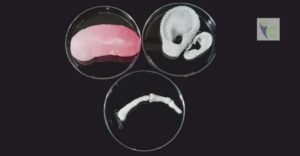Artificial Organs
Transplantation has always played a crucial role in the history of healthcare, by saving millions of lives. Though the world is populated almost by 7.8 billion, there will be always scarcity for the donated organs. We all know about organs, but are we aware of what thetray are made of? Well, it is a cumulative collaboration between cells and tissues to carry out a specific function. In simple terms, But, eventually by some way or other they fail to do job, it might be because of ageing or due to diseases.
Leading to detoriation of the organ and further hampering the proper functioning of the body. And, such damaged organs are needed to be replaced by healthy ones in time. Mostly, the organs are extracted if and only if the human body is dead causing unavailability of organs when needed. To overcome such concerns, doctors are implementing biotechnological aspects to attain innovative ways to create organs artificially for transplantation. And, artificial pancreas is the hottest topic rising in the markets. Here are some 4 aspects that you might want to know about.
Benefiting To Every Transplantological Aspects
Over the course of the past few decades, organ transplantation with the help of technology has almost kept up the expectations by overcoming various difficulties and problems. Earlier, it was quite difficult for scientists to preserve organs for longer period of time perhaps the new emerging technologies has more or less sorted this issue. By implicating artificial organs we might be able to fill up the void of organ unavailability in medical centers.
Meanwhile, there are certain times when the body opposes the organ transplant as it identifies the new organ as a foreign object and tries to destroy it; opposition of organs in the system is known as transplant rejection. This rejection is caused due to the incompatibility between organ, and the body, as the organ is part of another system. The incompatibility issue can be overcome by using artificial organs instead of donated ones.
Artificial organs are created according to the gainer’s system so that it may suppress the body’s immune responses and show compatibility with the system. Other hand, scientists have directed their attention in developing organs by new techniques such as bioengineering and invitro-grown organs. While there’s a slight difference between both of the methodology.
Technologies to Intervene Into Transplantation
 Biotechnology has been playing a crucial role in the development of healthcare and medicine. Scientists are implementing various technologies to ease-up the medical processes. Meanwhile, artificial organs are being created with the help of bioengineering and medically growing processes.
Biotechnology has been playing a crucial role in the development of healthcare and medicine. Scientists are implementing various technologies to ease-up the medical processes. Meanwhile, artificial organs are being created with the help of bioengineering and medically growing processes.
Understanding of artificial organs manufacturing in brief:
Creating Organs through Bioengineering
Natural organs may fail depending on the situation, these organs can be replaced by a new engineered one which allows the cells to develop and function accordingly. This is an innovative approach for producing organs resulting in the reduction of scarcity of donor organs. Currently, bioengineering is utilizing 3D printing methodology for manufacturing organs for treatment as well as for educational process. 3D printing could be proving itself as a major breakthrough in the medical industry. Yet, experiments and testing are on run, in order to determine the proper compatibility between the human body and artificial printed organs. In future, 3D organ shows the possibilities of getting implemented in various aspects.
Meanwhile, the creation of organs through printing is much easier as the design of the organ has to be programmed first and then layer by layer printing of the structure takes place reducing the complexity of organs manufacturing. A scientist has successfully bioprinted thyroid gland as well as patches of beating heart cells. These organs are printed by using a refined type of bio ink which has to be synthesized in separate labs. Various reports describe that soon the 3D printing will be printing heart once, the suitable printing material is successfully tested. So that, printed organs are successfully utilized for medical process and surgical studies.
Growing Organs Artificially
 Artificially grown organs should not be confused with bioengineered organs. Unlike bioengineering, this technology prefers the use of stem cells for manufacturing the organs. Scientists have come-up with an idea to generate a series of tissues with the help of pluripotent stem cells, opening the gates for the production of organs. Stem cell has the ability to generate tissues, and organs by some changes and commands provisions.
Artificially grown organs should not be confused with bioengineered organs. Unlike bioengineering, this technology prefers the use of stem cells for manufacturing the organs. Scientists have come-up with an idea to generate a series of tissues with the help of pluripotent stem cells, opening the gates for the production of organs. Stem cell has the ability to generate tissues, and organs by some changes and commands provisions.
These stem cells are taken from the human body and are prepared for growing on a cartilage base, which further is injected back into the system. This injected cartilage grows into an organ, inside the body. For example, recently an experiment was conducted by some scientists where a patient suffered from ear damage. To replace the damaged ear of the patient, the cartilage base must be compatible with patients system.
Instead of replacing the damaged part with new one from another system, scientist took stem cells from the deceased body and created a mini-cartilage framework. Further, the mini-cartilage injected into the arm of the deceased providing the cartilage a compatible natural habitat to grow. Later with the help of surgery, the damaged ear will be replaced by the grown one. Hence, implanting such technology will help doctors to create organs from the same cell of the patient’s body without facing the compatibility and transplant rejection issues.
Whereas, scientist are using robots to grow min-organs faster than humans ever could have. These robots are supplied with pluripotent stem cells made to be transformed into any type of cell; robots take 21 days to finish the process of forming cartilages skeletons of the organs. It has been reported that the process is much faster-taken place with robots under human supervision rather than prepared by humans themselves. Also, the research stated that the robot does take only 20 minutes to perform a work where most humans take one whole day. Thus, scientists are giving more preference to robots for the production of artificial organs as they are more efficient.
Technology is travelling faster than it was ever estimated. Whereas, this artificial technology has not only proven as a major breakthrough in transplantology, but also, did open up the gates for the new opportunities and possibilities. Transplantology is a vast medical field while, scientists have only succeeded to extract a fraction of it. Hopefully, the future of medical science will be evolved enough to overcome all real-time difficulties and issues. Implementing artificial organs will save numerous lives due to its irrelevant dependency on the donors.
-Bhushan Ghate









